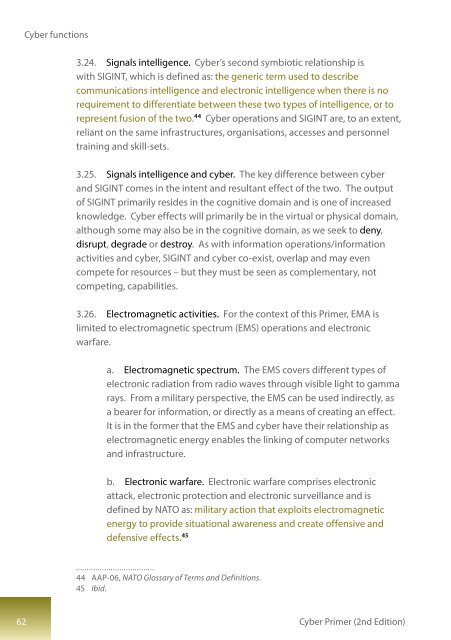Cyber Primer
AEWhbF
AEWhbF
You also want an ePaper? Increase the reach of your titles
YUMPU automatically turns print PDFs into web optimized ePapers that Google loves.
<strong>Cyber</strong> functions<br />
3.24. Signals intelligence. <strong>Cyber</strong>’s second symbiotic relationship is<br />
with SIGINT, which is defined as: the generic term used to describe<br />
communications intelligence and electronic intelligence when there is no<br />
requirement to differentiate between these two types of intelligence, or to<br />
represent fusion of the two. 44 <strong>Cyber</strong> operations and SIGINT are, to an extent,<br />
reliant on the same infrastructures, organisations, accesses and personnel<br />
training and skill-sets.<br />
3.25. Signals intelligence and cyber. The key difference between cyber<br />
and SIGINT comes in the intent and resultant effect of the two. The output<br />
of SIGINT primarily resides in the cognitive domain and is one of increased<br />
knowledge. <strong>Cyber</strong> effects will primarily be in the virtual or physical domain,<br />
although some may also be in the cognitive domain, as we seek to deny,<br />
disrupt, degrade or destroy. As with information operations/information<br />
activities and cyber, SIGINT and cyber co-exist, overlap and may even<br />
compete for resources – but they must be seen as complementary, not<br />
competing, capabilities.<br />
3.26. Electromagnetic activities. For the context of this <strong>Primer</strong>, EMA is<br />
limited to electromagnetic spectrum (EMS) operations and electronic<br />
warfare.<br />
a. Electromagnetic spectrum. The EMS covers different types of<br />
electronic radiation from radio waves through visible light to gamma<br />
rays. From a military perspective, the EMS can be used indirectly, as<br />
a bearer for information, or directly as a means of creating an effect.<br />
It is in the former that the EMS and cyber have their relationship as<br />
electromagnetic energy enables the linking of computer networks<br />
and infrastructure.<br />
b. Electronic warfare. Electronic warfare comprises electronic<br />
attack, electronic protection and electronic surveillance and is<br />
defined by NATO as: military action that exploits electromagnetic<br />
energy to provide situational awareness and create offensive and<br />
defensive effects. 45<br />
44 AAP-06, NATO Glossary of Terms and Definitions.<br />
45 Ibid.<br />
62<br />
<strong>Cyber</strong> <strong>Primer</strong> (2nd Edition)


